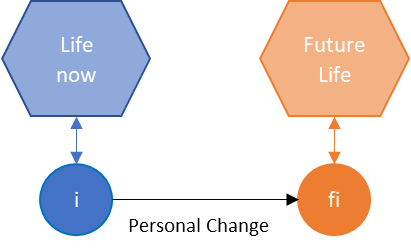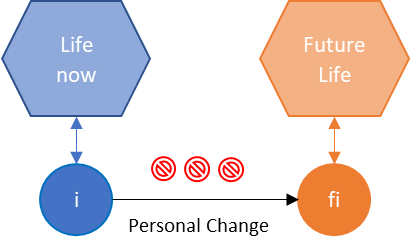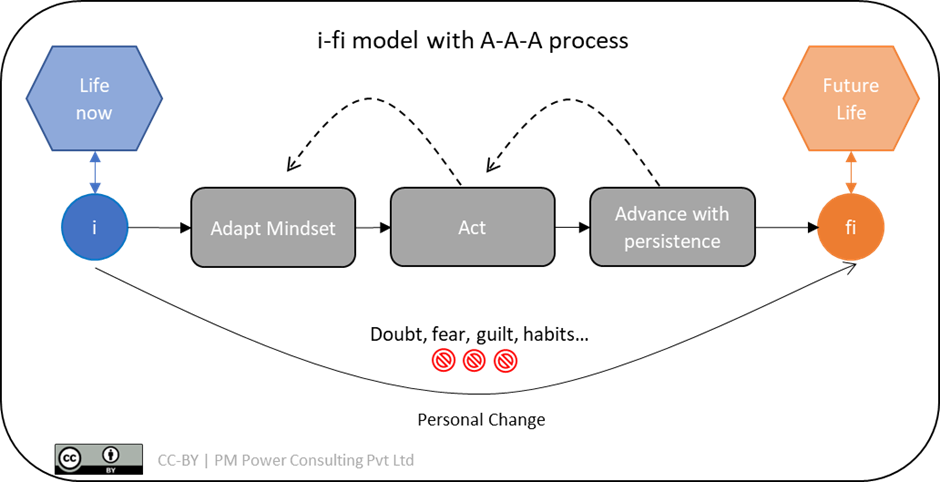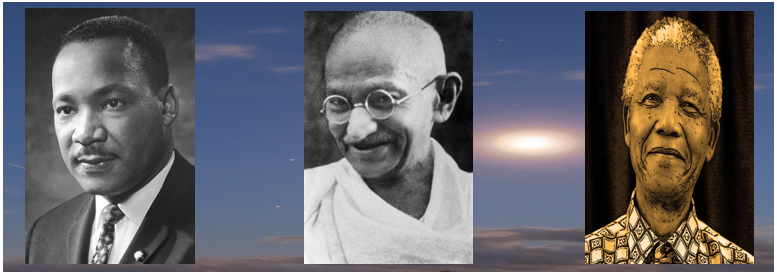Abstract
This article is the author’s narrative based on his ongoing journey of personal change. Emphasis is on proactive personal change fueled by the desire to shape one’s future. The author progressively outlines a model that could help the readers in their journey. Many ideas are stitched together in a unique way based on author’s own experience.
Introduction
While I watch movies for fun, some dialogues have had a lasting impact on me. Here is one from the movie “The Day the Earth Stood Still” where Professor Barnhardt tells the extra-terrestrial, Klaatu, who intends to erase the entire human race to save the earth: “You say we are on the brink of destruction, and you are right. But it is only on the brink that people find the will to change. Only at the precipice do we evolve. This is our moment. Don’t take it from us, we are close to an answer”.
Many of us can relate to that based on our own experiences. I had a colleague who refused to quit smoking but stopped the day he fainted due to a blood clot. I had another friend who stopped hitting his wife when she threatened to leave him with their child. Why look elsewhere? I always talked about spirituality but never took it up until I lost my wife to cancer. Crisis or impending crisis seems to trigger change.
There are other times I have changed when I felt I was pushed to the wall. I chose actions that were uncomfortable but were needed to break free of the constraints. A few examples: I was in a town where they spoke an unknown language and I had to learn. I had to change to succeed in a new organizational role that I was ‘given’! As Viktor Frankl puts it: “When we are no longer able to change a situation, we are challenged to change ourselves”. Having said that, there was another time, when I was asked to report to a boss that I was not ‘happy’ with, and I changed my job!! Ironically, that demanded greater change!
Above examples are about reactive change – in response to a situation. In this note, I would like to focus on proactive change, which I believe is harder but many times more rewarding.
Personal change is not a new topic for many of us and it is a well-researched area. I am sure we all have learnt models. If not, a simple google search will enlighten us with many approaches.
In what follows, I will share a model that works for me and bring in a few nuances based on my life experiences. Here we go.
Comparison
It is normal to use the lives of others as yardsticks to measure our level of so called ‘success’ in life. We want to know how we stack up in the social order. We may compare downward and feel kind of good about ourselves or compare upward and feel low about ourselves. There is obviously some good and bad in both directions. Downward comparison could lead to stagnation in your growth or even worse, you constantly need people ‘lower’ than you to maintain a healthy level of self-esteem. On the other hand, comparing upward could inspire you to strive for something greater. It can also lead to jealousy and lower self-esteem.
There was the early part of my career when I lived and worked in Australia. After a decade there, I felt good about my job role and the money I was making – in comparison to my peers. I decided to return to India feeling absolutely confident about myself and took up a new job. My manager, in a friendly conversation, told me how I had wasted my years in Australia, and I could have been much more successful if I had stayed back in India. Obviously, he meant well but I looked around and felt miserable! The same me – confident one day and miserable the next!!
Another decade passed and here I was attending the silver reunion of my engineering college – a minefield for comparisons! While it was fun reminiscing about the good old times, a couple of us couldn’t help discussing why we were not further ahead in our lives.
Personally, I found comparison (upward or downward) limits me and worse, it could mis-direct me.
Models
Many change models exist that support organizational change. A simple Google search will throw up a list for you. Some models have been adapted or extended for individual change – after all, organizations are made up individuals. There are many individual change models as well; some that start with change as a given and some, from the world of self-help gurus, start with figuring out what you want out of life.
I have not personally applied a standard model for personal change – hence it is a learning experience for me to derive a model from my personal journey. I may not invent something totally new, but I am sure the experience will be energizing. Here we go.
i-fi model
While I do fall into the trap of comparing myself with others, that has generally not helped me change for the better. For a few years, I went through the process of figuring out what I want to have and working towards it. Now I subscribe to what I call “i-fi” model. There are two tiers to it, as you will see this unfold.
At the higher level, I visualize the “Future I (fi)” and think what I (i) need to change to become that. It is not that there is no ‘have’ aspect to the visualization, but the focus has shifted to what I need to become to get close to the Future I.
Are you curious? Why lower case ‘i’ instead of upper case ‘I’? Let us reflect on the process of understanding today’s I. I am the observer, and I am the observed. I think that results in a somewhat distorted view – that’s the reason for the small ‘i’. There are super self-aware beings who can get the real ‘I’. I am not one of them. For some, the answer to the question, ‘who am I?’, has a deep spiritual significance. We will not go that deep in this note. In this model we will restrict ourselves to answers to questions like ‘what kind of person am I?’, ‘what is my world?’, ‘what do I think of the people around me?’, ‘how do I perceive the world around me?’, ‘What opportunities do I see?’, ‘Am I happy with my life as it is?’, ‘Where am I heading?’, ‘what are my beliefs and values?’, ‘What are my underlying qualities like courage, acceptance, love, etc.’. This list is not meant to be a definitive one. There is one question I would highly recommend though: ‘How do I feel about myself?’ – thanks to one of my mentors, late Mr. Frank Tennant from Australia. That question kind of sums it up for me. Essentially, ‘i’ determines my current life!
Now how do I visualize the future ‘I’? There is a ton of literature on dreams, visualization and goal setting in the public domain. Typical focus areas are financial, career, family, health, etc. My approach to visualizing ‘fi’ is not very different. Here are a few keys to my approach:
- ‘fi’ is not limited by ‘i’ – i.e., where I am today does not govern where I could be in the future.
- While I typically visualize around a holistic set of focus areas, I implicitly understand that there are two or three essential ones. I often would not know which these are at the beginning, but they emerge as I move forward and prioritize my time and focus. There would be those wonderful times in your life – a single area has all the force of your will, and you make unbelievable progress towards the desired future!
- I like to have a purpose statement that kind of acts as common underlying thread. If this purpose is being fulfilled, I can confidently answer ‘Yes’ to the ‘How do I feel about myself?’ question. I wouldn’t say this is mandatory because I struggled with coming up with a purpose statement initially. I must say it kind of evolved and will probably continue to evolve.
- There is a new one I have added recently to my repertoire – that is ‘my philosophy’ statement. It kind of helps me navigate the ebbs and flows of the journey from ‘i’ to ‘fi’.
- I would highly recommend working with a coach to figure this out. I had lost my wife, Rathiga, to cancer. I struggled for more than five years to give some direction to my life. It is not that I was depressed. I had accepted the situation but was kind of drifting through life. A couple of sessions with Dr Colleen Lightbody, an amazing master coach helped me to get going.
- Finally, I am willing to accept that the ‘Future I’ could change and is not absolute. That’s the reason I use the smaller case notation – ‘fi’.
It is not necessary for everyone to define their ‘fi’ to live a fulfilling life. There are some who find it stressful to have defined goals; some are content with the way things are; some believe that a positive outlook to life is adequate; some feel that they are at a stage in their life, they are not motivated to take on more challenges.
Just the way ‘i’ determines my current life, ‘fi’ determines my future life!

The journey from ‘i’ to ‘fi’ demands Personal Change!
Impediments to Personal Change
For some reason, when there is clarity in the mind on the why, we are motivated to move forward with courage. Science says, our Reticular Activation System in our brain brings relevant opportunities to our attention and filters out distractions! Strategies evolve and we develop a sense of urgency that propels as forward.
Let us pause here. All that sounds simple enough to do – then why is that not many have been able to get to the desired Future state? What holds us back?

While I have deliberately thought up the desired future state in my mind, I found there are other thoughts that seed doubt. Doubt poisons the will and slows us down. Circumstances seem to get in the way, and one loses the will to act. Slowly I stop believing that the desired future is not possible and settle down for something less. Why does this happen?
What decides the kind of thoughts that spring to my mind? Beliefs, values and attitudes influence our thoughts. The deep-rooted beliefs and values formed as a result of past experiences. Our mind has stored various events in our life with specific details along with some thoughts – self-talk. Over a period, these form beliefs that are unshakable. Let me give a simple example. I was chased and attacked by a stray dog when I was young. I have been chased by strays while riding a bike. It is hard for me to feel comfortable with the gentlest of dogs. I had to become aware of this fear and deliberately pet domesticated dogs many times over to reduce this fear. Basically, I created new experiences which helped to re-shape my belief about dogs. That sounds simple enough when it comes to dogs. Now what about the impossible project deadline; most difficult boss in the whole world; mean spouse who once was the love of your life; the stock market that always works against your investments; losing a job at the time of recession; a career that seems to have hit a wall? Are these ‘external’ circumstances my fault?
Here is a quote from James Allen from ‘As a man thinketh’: “Man is buffeted by circumstances so long as he believes himself to be the creature of outside conditions, but when he realizes that he is a creative power, and that he may command the hidden soil and seeds of his being out of which circumstances grow, he then becomes the rightful master of himself”.
All the thinking is not enough; I am not saintly enough to create just by thought. Action is definitely needed to manifest the desired outcomes. In the process of ‘acting’, personal change happens. ‘fi’ starts emerging!
What if I ‘act’ but the result is not in line with my expectations of Future Life? I start feeling I failed. Consequences often hurt. Courage disappears and fear arises – no desire to go through that again! There are times that I feel the failure was caused by someone else – dislike develops for that person and has the potential to turn into anger. Recently, I got very poor feedback in a consulting engagement. I felt it was just triggered by one person and most of it is not justified. I pulled myself together, introspected and made a mental resolution to improve myself. However, I could sense a residual shade of disaffection for the individual. I am sure I will be able to get over that with time.
What if I do not ‘act’ on the thought? I have found, ‘Knowing what to do’ is relatively easy but ‘Doing what I know?’ is a lot harder! For me, there are a couple of reasons.
First reason is my set of habits. These are my friends and, also my enemies. They are unbelievably hard to break. Habits make me do something else instead of the action I should be taking. Let us take an example here: One aspect of my ‘fi’ is to be mentally sharp and physically active through my entire life. I learnt in a program that quality of sleep has a significant impact on mental sharpness. I had observed that my quality of sleep had deteriorated over time. The suggestion was to reduce screen time an hour prior to sleep. I have the habit of watching something in my mobile after going to bed. I have been trying to break this habit for the last three months to no avail. I delete Netflix, Prime and Hotstar from my mobile but they always manage to get re-installed!
Second reason is the tendency to procrastinate. The delay takes the edge of the desired action, and the will eventually disappears. I have improved over time, but I still have a long way to go. My son, Vetri, is an inspiration in this regard – if it is important enough, he gets on top of it NOW!
Inaction results in guilt – a very powerful emotion that pulls one down. Overall, fear, anger and guilt create restlessness in one’s heart and a state of dis-orientation.
How do we break out of this? What’s missing?
A process for Personal Change: A-A-A
The process of personal change has three steps: Adapt one’s mindset, Act, Advance with persistence (A-A-A).

Step 1: Adapt one’s mindset
I start with examining my mindset – habits, attitudes, beliefs, values – in the context of the change and the desired goal. I look for anything that is misaligned to the future I and the necessary actions. Maybe, I need to change my beliefs or break some habits or strengthen my attitude. Let me share a recent example that many of you can relate to. A situation arose where my elderly parents would come to live with me and they needed care. One of my core values has always been ‘be a dutiful son’. It is a part of the future ‘i’ to be dutiful and maintain a genuine connection with my parents. When I heard the experiences of others who looked after their parents, I realised I needed to review my mindset. I realised I had three choices: to see this as a burden; or my duty; or a blessing. I chose to make it a blessing. I needed to adapt my mindset proactively to create the right fertility conditions for the next step: Act.
Step 2: Act
We have discussed impediments to action. Wonderful outcome about action is not necessarily the result but personal change! Action results in new experiences and leads to changes in our belief system. Impediments provide the necessary resistance to strengthen our mental muscles. Right attitude and persistent action can reduce the turbulence in the heart – less of fear, anger, and loss of belief!
Going back to the example of caring for my parents, I found that love begets love, but also found that anger begets anger, impatience begets impatience, fear begets fear, irritability begets irritability. I need to act with the right emotions to create an environment where love, respect, patience, acceptance grow.
Step 3: Advance with persistence
After ‘Acting’, we need to learn from the results and continuously refine the next steps and the mindset. Critical aspect of step 3: you are always advancing irrespective of the results as long as you are learning from the experience. For me, persistence comes from feeding the will – that could come by reminding myself of the future I and visuals of the future life; it could also come from my supporters; it could also come from a mentor or a guide.
Again, using the example of caring for my parents, I had to correct myself and find new ways of moving forward – may it be apologizing, taking them out, playing board games & cards, watching tv together.
Essentially, you are looping back to previous steps of Adapting your mindset and finding new ways to Act. Just remember impediments do not fully vanish and continue to play a role in shaping the ‘fi’. The loftier the ‘fi’, the stronger the resistance, and the greater the struggle to overcome them!
Conclusion
Complete i-fi model with A-A-A process is depicted in the picture below.

I am immensely grateful to the mentors and coaches who have guided me through this process so far and continue to do so.
In closing, I would like to share a couple of ideas that are proven but I am working on personally experiencing them. First one is about meditation. I am sure meditation will improve self-awareness and self-discipline necessary to move predictably towards your ‘future I’. Second idea is about humility. We talked about impediments to your journey from ‘i’ to ‘fi’ like doubt, fear, guilt, anger, habits, etc. As opposed to those there are a few friendly qualities: love, patience, tolerance, acceptance, faith, etc. Those are great qualities to have but if you do not have humility all is lost. I will close with a passage from the book: ‘Designing Destiny’ by Kamlesh Patel.
“In the Bhagavad Gita, Lord Krishna mentions the great qualities we must have in order to tackle the struggles of life. He uses an analogy: Life is like being protected inside a palace in which we live. Imagine that the palace is protected by a wall with one noble quality protecting each gate of that wall. It is the back gate that is the most vulnerable in a palace, as nobody pays attention to it, and that is the gate of humility, which generally remains unseen because it is so small. It doesn’t call for our attention. It is the place from which most enemies attack, the most unexpected place. Lord Krishna says that this gate must always be protected by humility. If we do not have humility, all the other gates are vulnerable”.
Template
We do have a Powerpoint template provides an approach for visualizing your future state. Notes in the slides would help you to use the template. Please do reach out to me, if you are looking for further guidance or a free copy of the template. My email id is ananth@pm-powerconsulting.com. A few images from the template below:

Epilogue
i-fi model assumes there is an ‘I’ that has a current state and a future state. There are broader questions that spiritual seekers ask themselves: Who am I? Where did I come from? Where am I going? Will I always exist in some form? Answers to these questions could vary depending on your faith and what you believe in.
I am not an expert to answer these questions with conviction, yet. However, I have chosen to believe in a spiritual journey that would span this life and beyond – with the goal of god-realization – a state in which ‘I’ melts away and you become one with God. i-fi model can therefore be extended to ‘i-fi-ni’ model where there is no ‘I’ in the end state.
References
- Social Comparison Theory – Leon Festinger
- Post in psychology today on social comparison theory
- Perils of comparing ourselves to others – Dr Juliana Breines
- Change Management Models – Zendesk – Kristen Hicks
- Why you need an individual change model – Tim Creasy – Prosci
- 12 steps to change your life, Tony Robbins style – Dr Margie Warrell
- Think or Sink – Book by Gina Mollicone-Long
- As a man thinketh – Book by James Allen
- Designing Destiny – Book by Kamlesh Patel



